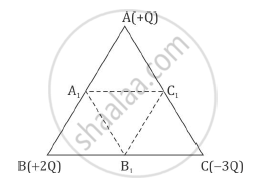Advertisements
Advertisements
प्रश्न
Three point charges, + Q + 2Q and – 3Q are placed at the vertices of an equilateral triangle ABC of side l. If these charges are displaced to the mid-point A1, B1 and C1, respectively, find the amount of the work done in shifting the charges to the new locations.

उत्तर
q1= +Q
q2= +2Q
q3= -3Q
r = l (for each side)
Intial potential energy of system
`U_1=1/(4piin_0l)[(q_1xxq_2)+(q_2xxq_3)+(q_3xxq_1)]`
`U_1=1/(4piin_0l)[(Qxx2Q)+(2Qxx(-3Q))+((-3Q) xxQ)]`
`U_1=(-7Q^2)/(4piin_0l`
These charges displaced to mid points then final potential energy of system,
`U_2=1/(4piin_0l/2)[(q_1xxq_2)+(q_2xxq_3)+(q_3xxq_1)]`
`U_2=2/(4piin_0l)[(Qxx2Q)+(2Qxx(-3Q))+((-3Q)xxQ)]`
`U_2=(-7Q^2)/(2piin_0l)`
Work done, W = U2 - U1
`W=(-7Q^2)/(2piin_0l)-(-7Q^2)/(4piin_0l)`
`W=(7Q^2)/(piin_0l)[(-1)/2-((-1)/4)]=(7Q^2)/(piin_0l)[(-1)/2+1/4]`
`W=(-7)/4(Q^2/(piin_0l))`
संबंधित प्रश्न
A small test charge is released at rest at a point in an electrostatic field configuration. Will it travel along the field line passing through that point?
We know that electric field is discontinuous across the surface of a charged conductor. Is electric potential also discontinuous there?
Obtain an expression for an intensity of electric field at a point at the end of position, i.e., the axial position of an electric dipole.
x
Two point charges of 10C each are kept at a distance of 3m in the vacuum. Calculate their electrostatic potential energy.
Three point charges +2, +2, and +5µC are placed respectively at the vertices A, B, C of an equilateral triangle of side 0.2 m. The magnitude of the force experienced by the charge at C is ______.
If stretch in a spring of force constant k is tripled then the ratio of elastic potential energy in the two cases will be:
In bringing one electron towards another electrons, the electrostatic potential energy of the system will.
When one electron is taken towards the other electron, then the electric potential energy of the system ______
In a region of constant potential ______.
- the electric field is uniform
- the electric field is zero
- there can be no charge inside the region
- the electric field shall necessarily change if a charge is placed outside the region
